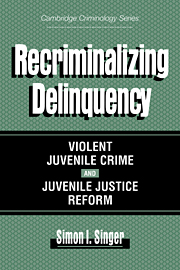Book contents
- Frontmatter
- Contents
- List of Figures and Tables
- Acknowledgments
- Introduction
- 1 Recriminalizing Violent Juvenile Crime
- 2 Taking Stock of Juvenile Justice Reforms
- 3 Recriminalization on the Move and Its Legal Rules
- 4 Contextual and Legal Reasons for Identifying Juveniles as Criminal Offenders
- 5 The Case Processing of Juvenile Offenders: From Arrest to Disposition
- 6 Recriminalization and Organizing for Deterrence
- 7 Convicted Juvenile Offenders in a Maximum Security Institution
- 8 Concluding “Real” Reasons for Recriminalizing Delinquency
- Appendixes
- Notes
- References
- Index
5 - The Case Processing of Juvenile Offenders: From Arrest to Disposition
Published online by Cambridge University Press: 29 September 2009
- Frontmatter
- Contents
- List of Figures and Tables
- Acknowledgments
- Introduction
- 1 Recriminalizing Violent Juvenile Crime
- 2 Taking Stock of Juvenile Justice Reforms
- 3 Recriminalization on the Move and Its Legal Rules
- 4 Contextual and Legal Reasons for Identifying Juveniles as Criminal Offenders
- 5 The Case Processing of Juvenile Offenders: From Arrest to Disposition
- 6 Recriminalization and Organizing for Deterrence
- 7 Convicted Juvenile Offenders in a Maximum Security Institution
- 8 Concluding “Real” Reasons for Recriminalizing Delinquency
- Appendixes
- Notes
- References
- Index
Summary
the task of assigning criminal responsibility to juveniles takes place within systems of criminal justice. Defining a population of juveniles as offenders instead of as delinquents depends on the jurisdictional and temporal location of criminal justice officials. The implementation of the JO law's legal rules is based on more than just what is technically stated as a JO offense and an eligible juvenile offender. Case processing decisions require the police to make arrests, prosecutors to charge juveniles as adult offenders, and judges to determine the type and length of sentence.
In this chapter, I stress that the assignment of criminal responsibility to juveniles is often independent of offense severity and the personal characteristics of juveniles. Who is arrested, convicted, and incarcerated as a juvenile offender reflects temporal and jurisdictional contexts that go beyond the individual characteristics of a JO case. There is an organizational context that is rooted in the practical concerns and interests of officials to produce what Emerson (1991) refers to as “organizational contingencies.” To see the concerns and interests of legal decision makers is to see “a construction that decision-makers themselves use in assessing and showing the practical rationality of specific decisions” (Emerson 1991: 210). For example, in some jurisdictions the police may not want to arrest every juvenile as a juvenile offender for every eligible C felony offense, because they know that prosecutors will routinely dismiss such offenses as not worthy of charges in criminal court.
- Type
- Chapter
- Information
- Recriminalizing DelinquencyViolent Juvenile Crime and Juvenile Justice Reform, pp. 97 - 151Publisher: Cambridge University PressPrint publication year: 1996

